It seems that quite a few people had ideas on how to fix up my D. D. Deck from last week. Let’s get straight to some of your ideas!
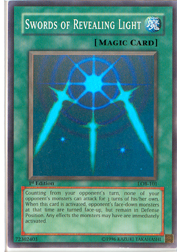 Jean-Marie Peloponese is trying to one-up Swords of Revealing Light.
Jean-Marie Peloponese is trying to one-up Swords of Revealing Light.
Jean-Marie sent me a decklist with a single copy of Messenger of Peace in the main deck with a little note next to it saying “(really useful in this deck).” I tried it out, and I must say that Messenger of Peace is truly excellent. The Messenger provides something for the deck to fall back on if you start to run out of cards in hand, or even if you just aren’t getting anything useful. The only problem I found is that it doesn’t stop Tsukuyomi from hitting you for 1100 damage or from getting rid of whatever monster it may have flipped down during the turn.
Lots of people sent this idea in, but Jeff Hanson’s letter got to me first.
I was thinking that Big Bang Shot might be a good addition to the deck. Since you already run two Giant Trunade and it works well with D.D. Survivor, Big Bang Shot might be something to think about.
Big Bang Shot seems to be an excellent addition to the D. D. Deck. Not only can it be used to boost your Survivor’s attack, it also gives it the ability to deal “piercing” damage through the omnipresent Sheep tokens in the Advanced-format environment. Additionally, due to D.D. Survivor’s effect, Big Bang Shot’s negative effect is nearly meaningless. You can also use it with Giant Trunade to perform the Ben Kei deck’s signature removal trick: Equip an opponent’s monster with Big Bang Shot. Play Giant Trunade. Laugh on into the night.
Many thanks to everyone who wrote in about last week’s deck. These are some pretty great ideas that are sure to help out anyone who chooses to try the D.D. Deck. Now then, on to this week’s business!
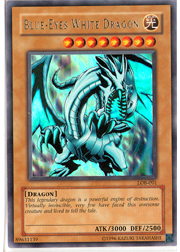 Obliterate!
Obliterate!
I admit it—ever since I saw the first episode of the TV show, I’ve had a bit of a soft spot for Exodia. I mean, who wouldn’t? Exodia just beat three Blue-Eyes White Dragon as if they were nothing! Later on after I started learning to play the actual game, I realized that it was harder to win with Exodia than they made it look on TV. A lot harder.
Now, fast-forward to today’s environment. In these days when many duels are defined by who uses and reuses the most trinity cards the fastest, it would seem that a win through Exodia is all but impossible. However, I refuse to accept this as inevitable.
Exodia has always had a few things going for it since the very beginning of the game. First, it’s a surprising deck. Back in the day, the only Exodia pieces you could get were the ultra-rares from Legend of Blue-Eyes White Dragon and the promotional Exodia the Forbidden One from the Dark Duel Stories video game. This meant that the pieces were expensive and hard to obtain. Needless to say, most people didn’t bother. However, those who did manage to get all the pieces usually played them. The problem was that when you played one of these people they usually didn’t come right out and tell you they were playing Exodia. You only found out once they searched a piece out with the first Sangan you attacked. From that point on, you had to change your entire strategy from “win” to “win as fast as possible, only stopping to use and reuse Card Destruction.”
 The second advantage of Exodia decks was that they could win the game at any time. The opponent had almost no way to know how many pieces the Exodia player was holding, if he or she had Backup Soldier, or if one of his or her face down monsters was Witch of the Black Forest, (or anything else, for that matter). That gave the Exodia player a huge psychological advantage, and it still does.
The second advantage of Exodia decks was that they could win the game at any time. The opponent had almost no way to know how many pieces the Exodia player was holding, if he or she had Backup Soldier, or if one of his or her face down monsters was Witch of the Black Forest, (or anything else, for that matter). That gave the Exodia player a huge psychological advantage, and it still does.
Finally, if you did get the fifth piece of Exodia in your hand, you won the game instantly. No chaining, no negation, nothing. This means that if you drew the fifth piece, but your opponent had just set a deadly Ceasefire, you’d win the game before your opponent could even begin to contemplate activating that Ceasefire. It’s the kind of deck that actually wins by drawing cards, rather than merely being set up to win. With the heavy emphasis on card advantage these days, I think a deck where drawing cards will literally win you the game is a great idea.
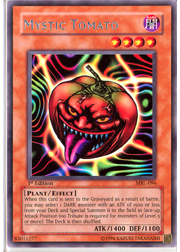 Monsters: 18
Monsters: 18
1 Exodia the Forbidden One
1 Left Leg of the Forbidden One
1 Left Arm of the Forbidden One
1 Right Arm of the Forbidden One
1 Right Leg of the Forbidden One
2 Mystic Tomato
1 Sangan
2 Magician of Faith
2 Night Assailant
2 Emissary of the Afterlife
2 Toon Cannon Soldier
1 Morphing Jar
1 Sinister Serpent
Spells: 20
1 Pot of Greed
1 Graceful Charity
2 Upstart Goblin
2 Level Limit – Area B
2 Messenger of Peace
2 Dark Factory of Mass Production
2 Book of Moon
2 Monster Reincarnation
3 Toon Table of Contents
1 Premature Burial
2 The Shallow Grave
Traps: 2
1 Call of the Haunted
1 Torrential Tribute
 Drawing Cards Wins Games. Literally.
Drawing Cards Wins Games. Literally.
Traditionally, Exodia decks won by getting as many copies of Witch of the Black Forest and Sangan sent to the graveyard as humanly possible. That’s not exactly possible these days, considering that Witch of the Black Forest is on the Forbidden list and Sangan is limited to one copy per deck. Emissary of the Afterlife helps out a bit with that, but it can’t fetch Exodia the Forbidden One, nor can it be searched out with Mystic Tomato. You can still revive it and launch it for a piece, though, and that’s good enough for it to be included in this deck. Sangan is still the go-to guy for fetching Exodia limbs, so I’ve made sure to provide plenty of opportunities for it to get out there and get itself blown up.
The thing that I like most about this deck is its deck-thinning capabilities. Since your opponent’s life points don’t matter when you’re playing this deck, two Upstart Goblins are a must. Combine those with three Toon Table of Contents and you can get an extra five cards out of your deck. Toon Table of Contents is proving to be an excellent card in a number of decks. Essentially, any deck that currently uses Thunder Dragon could just as easily play three Toon Table of Contents, and not only would they get an extra card out of their deck, it would be a good card, like Toon Cannon Soldier, as opposed to a tribute monster with terrible stats. Yes, I know that Thunder Dragon is a Light monster, but honestly, you probably already have better Light monsters in your deck. Just remove that Magician of Faith or something.
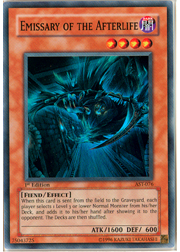 To get back on topic, Toon Cannon Soldier is going to be your main method of putting Sangan and Emissary of the Afterlife into the graveyard. It can be searched out with both Toon Table of Contents and Mystic Tomato, so it shouldn’t be too difficult to get into play. It may not be able to attack on the turn it comes out, but that doesn’t actually matter, because you won’t be attacking anyway. Toon Cannon Soldier is just as good at chucking unnecessary monsters at the opponent as any other Cannon Soldier, so there’s no need to feel bad about having a Toon monster in your deck.
To get back on topic, Toon Cannon Soldier is going to be your main method of putting Sangan and Emissary of the Afterlife into the graveyard. It can be searched out with both Toon Table of Contents and Mystic Tomato, so it shouldn’t be too difficult to get into play. It may not be able to attack on the turn it comes out, but that doesn’t actually matter, because you won’t be attacking anyway. Toon Cannon Soldier is just as good at chucking unnecessary monsters at the opponent as any other Cannon Soldier, so there’s no need to feel bad about having a Toon monster in your deck.
The final component to the deck is its ability to revive the Sangan and Emissary over and over again so that Toon Cannon Soldier can repeatedly launch them. Combo deck favorite The Shallow Grave makes a guest appearance in this deck to help out with that recursion. I’ve also included the mainstays, Call of the Haunted and Premature Burial, to make sure I have enough ways to revive Sangan. This will ensure that it’s the only search monster I need to draw to win the game. Finally, I want to make sure I mention the lovely stall package of two Level Limit – Area B and two Messenger of Peace. Both are excellent cards that will keep you alive long enough to do your thing.
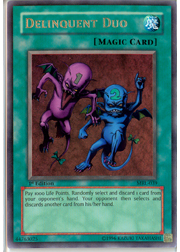 Delinquent Duo Can Happen to You!
Delinquent Duo Can Happen to You!
As usual, there are plenty of things that can go wrong when you’re playing this deck. The most prevalent one is the presence of Delinquent Duo in the current environment. If you get hit by Delinquent Duo once, you can probably hang on and survive. Maybe you’ll drop Night Assailant and Sinister Serpent. If you get hit with it two or three times, thanks to Magician of Faith, you’re probably going to lose. This deck has no way to deal any sort of life point damage to your opponent outside of Toon Cannon Soldier, and if you’ve been hit with a double or triple Delinquent Duo, it’s doubtful that you’d have the resources to win through the Soldier anyway.
The second most common way that Exodia decks lose is by getting hit with Cyber Jar and having a piece or two of Exodia on the field. When this happens, if you have no stall components at the time (or even if you do), bad things are going to happen to that Exodia piece. If you leave it in attack position, it’s going to get hit for a lot of damage—but if you put it face down, it could get removed by Nobleman of Crossout. Neither is something you want to have happen. In fact, Kycoo the Ghost Destroyer is another card that you don’t want to see on your opponent’s field. You have no way to retrieve cards that have been removed from play, so if any pieces end up in the removed zone, you should probably enter your scoop phase and move on.
Finally, you might end up facing a combo deck, such as Last Turn or Cookie Jar, or a Burn deck. You’re pretty much going to auto-lose to all of those decks in game one. Game two and possibly even game three don’t look much better, considering that it’s very hard to make a side deck for an Exodia deck.
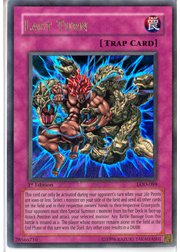 On the subject of side decks, your best bet is probably to do something similar to what Andy Wilson tried at SJC Seattle. Use your side deck to switch from Exodia to some other type of combo deck. Last Turn is probably the best choice from a gameplay standpoint, but fair warning to anyone who wants to try it—Last Turn won’t make you many friends. However, it will give you a shot against Burn and other Last Turn decks. Cookie Jar is a problem that you’ll need to address separately.
On the subject of side decks, your best bet is probably to do something similar to what Andy Wilson tried at SJC Seattle. Use your side deck to switch from Exodia to some other type of combo deck. Last Turn is probably the best choice from a gameplay standpoint, but fair warning to anyone who wants to try it—Last Turn won’t make you many friends. However, it will give you a shot against Burn and other Last Turn decks. Cookie Jar is a problem that you’ll need to address separately.
Keeping those three things in mind, Exodia decks can be a surprising way to win. A few duelists were even brave enough to try it out at Nationals, though sadly, it didn’t work out too well. If you do decide to try it out, and if you find anything interesting or effective that I haven’t covered here, feel free to send it in. As usual, I’ll post the best tricks and tech next week, and I’ll give proper credit to anyone whose suggestions I use. Special thanks this week to Karl for suggesting Exodia.
That about wraps it up for me this week. Send any questions, comments, suggestions, or ideas to jcmchale@andrew.cmu.edu. Until next time, play hard, play fair, and most importantly, have fun!
NEXT WEEK: Life Gain finds its place in the universe.